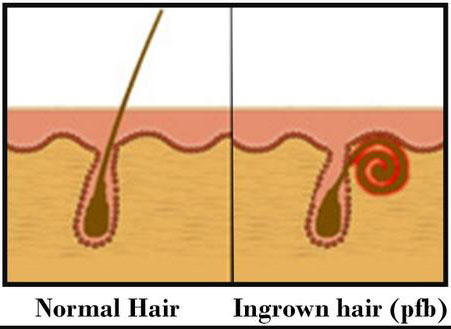 What Are Razor Bumps?
What Are Razor Bumps?
There are two classifications for razor bumps based on causation. Razor bumps that are caused by viral or bacterial infection are known as folliculitis barbae while razor bumps caused by irritation from shaving or ingrown hairs are known as Pseudofolliculitis barbae1, 3, 6.
Who Gets Them?
Razor bumps can happen to both males and females but are more prevalent in males. It is commonly found in the beard area for men. Pseudofolliculitis (shaving bumps) are especially common in people with curly hair because the curly hair grows back into the skin, known as ingrown hair, causing the irritation2. Women can get Pseudofolliculitis in shaved or plucked areas such as the bikini line, armpits, upper lips, and chin.
Bacterial causation of folliculitis barbae is usually due to infection with the bacteria Staphylococcus aureus (S. aureus)1. The bacteria can be spread to other hair follicles when the pus-filled spots in the area is cut by razors, causing bleeding and pus drainage 3.
Irritation can be caused by the groin and armpit area rubbing against tight clothing, especially during running.
What Are the Symptoms?
Symptoms usually consist of an itchy or sore area of small red raised swellings (spots) which can sometimes be filled with pus3.
Treatment and Prevention
Self-care treatment includes letting the hair grow without shaving. If you must shave, use an electric shaver that does not cut too close to the skin as well as moisturizing shaving foam. Shave every other day instead of daily. Using a single blade is more preferable than a double blade because a single blade does not cut the hair too short. Sterilizing metal parts of your shaver with boiling water, using disposable razors only once, and thoroughly cleaning any plastic part of your razor that comes in contact with the skin can help to prevent razor bumps. Shaving with the grain (the direction of the hair growth) can also help to prevent razor bumps.
Medical treatments for razor bumps can consist of a topical or oral antibiotics for severe cases with pus and abscess formation4, 5. Other topical medications such as tretinoin and topical combination cream (tretinoin 0.05%, fluocinolone acetonide 0.01%, and hydroquinone 4%) can help by reducing the inflammation and hyperpigmentation due to the inflammation 4,5. A more expensive method to prevent razor bumps is laser hair removal, but please consult your doctor before pursing this option.
References
- Oakley, A. and Gomez, J. July 2016. Folliculitis barbae and pseudofolliculitis barbae. DermNet New Zealland. Accessed 04/07/2017. http://www.dermnetnz.org/topics/folliculitis-barbae/
- American Osteopathic College of Dermatology (AOCD). Accessed 04/09/2017. Pseudofolliculitis Barbae. http://www.aocd.org/?page=pseudofolliculitisb
- British Association of Dermatologists (BAD). Published April 2017. Folliculitis Barbae. Accessed 04/09/20017. http://www.bad.org.uk/shared/get-file.ashx?id=203&itemtype=document
- Greidanus, T.G. February 10, 2016. Pseudofolliculitis of the Beard Treatment & Management
- Accessed 04/09/2017. http://emedicine.medscape.com/article/1071251-treatment
- British Association of Dermatologists (BAD). Published November 2016. Pseudofolliculitis. Accessed 04/09/20017. http://www.bad.org.uk/shared/get-file.ashx?id=122&itemtype=document
The information provided is for general interest only and should not be misconstrued as a diagnosis, prognosis or treatment recommendation. This information does not in any way constitute the practice of medicine, or any other health care profession. Readers are directed to consult their health care provider regarding their specific health situation. Marque Medical is not liable for any action taken by a reader based upon this information.


